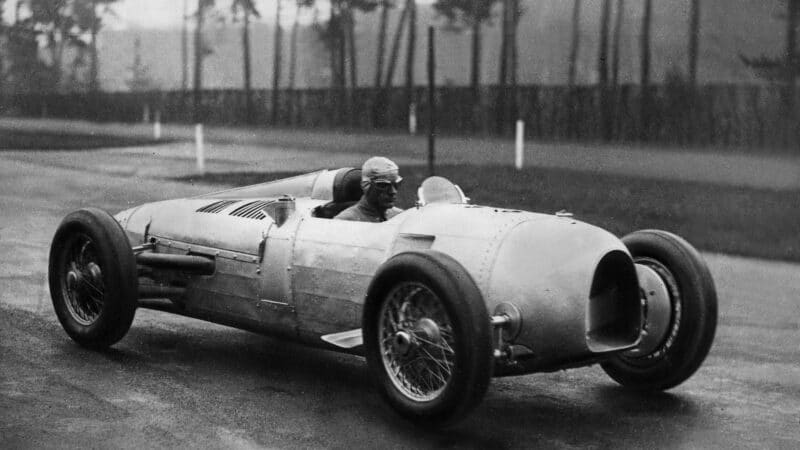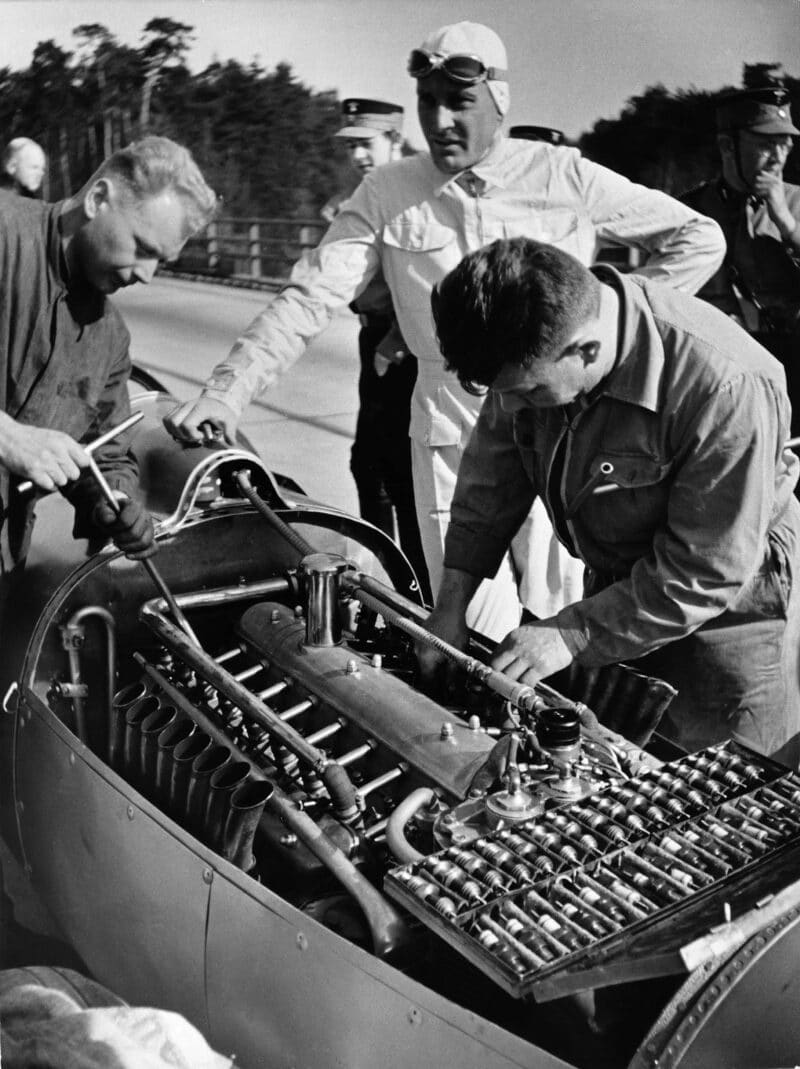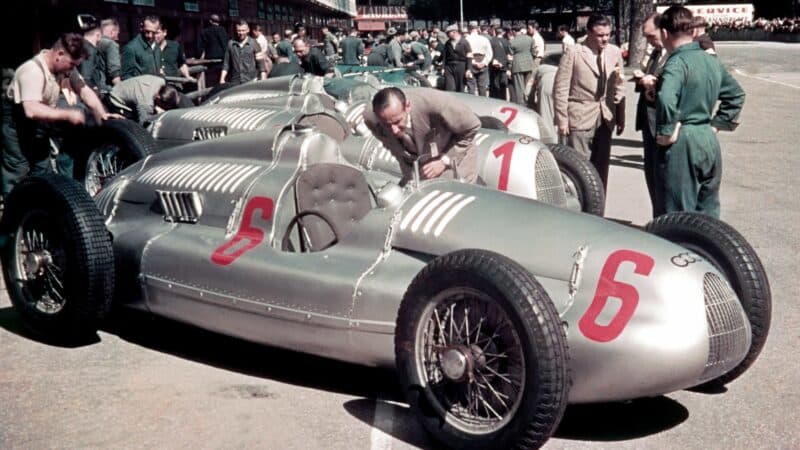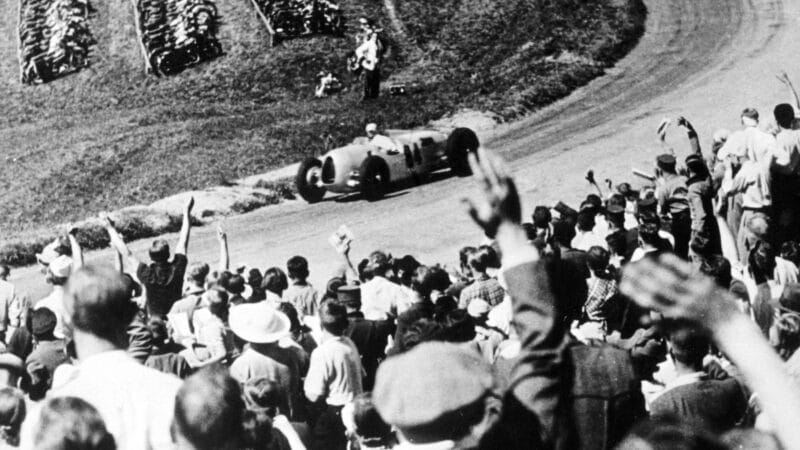Ferdinand Porsche and the Rise of Auto Union in 1930s Racing
Ferdinand Porsche’s radical V16 engine was the perfect fit for grand prix racing’s new pre-war formula. In the hands of Auto Union’s Bernd Rosemeyer, it brought German dominance to circuits across Europe

Getty Images
Taken from Motor Sport Online, December 2021
In 1933, a German car won only one major international race; the Finnish Grand Prix where local driver Karl Ebb took victory in a Mercedes-Benz SSK. Alfa Romeo and Maserati were the dominant forces of the day, with drivers such as Tazio Nuvolari and Luigi Fagioli sweeping all before them. Just three years later, the Italians barely got a look in as the European Championship was steamrollered by Auto Union three to one against Mercedes.
The march of the pre-war German racing machines was inexorably linked to Adolf Hitler’s rise to power, after the Fascist leader became the country’s chancellor in January 1933. Like many before and since, international sporting success was seen as a means to assert Germany’s status on the international stage and what better tool for the job than motorsport, representing as it does both the heroism of drivers and technological prowess?

The Auto Union P-Wagen of 1934, with Hans Stuck at the wheel during a test session.
At the same time as Hitler’s arrival on the scene, the Association International des Automobile Clubs Reconnus (AIACR) which set international racing regulations, concocted a new grand prix formula for introduction in 1934. In an effort to keep a cap on increasing car performance a maximum vehicle weight of 750kg was set, the rule-makers somewhat naively assuming that this upper limit would rule out large capacity, high-power machines. It didn’t.
In Germany, Mercedes was immediately on the case developing a design study for the new formula, but so too was a small company in Stuttgart headed up by the former technical director of Steyr Automobile, a certain Ferdinand Porsche. His outfit had been working on road car designs for the Wanderer marque, with Porsche encouraging the company to back a racing effort. However, Wanderer was merged, along with Horch, Audi and DKW to form Auto Union in late 1932, with the new entity initially non-committal towards racing.

Porsche poses
Undeterred, Porsche’s design agency, which included engine specialist Josef Kales; Porsche’s right-hand man Karl Rabe; Porsche’s son, Ferdinand aka “Ferry”; and Adolf Rosenberger, a well-heeled amateur racer, penned the outlines of a 750kg car, with financial backing from a close friend of Rosenberger. The group drew up a design for a car that marked a radical departure from what was then the norm; it would be mid-rear engined, with independent suspension all around and a V16 engine producing in the region of 300bhp.
“The rule makers thought this limit would rule out high-power cars. It didn’t”
The question was, who would pay to build it? Fortunately, Auto Union’s view of racing as a positive influence firmed up by early 1933, encouraged by the possibility of a racing subsidy from Hitler’s government. Though not a huge sum, the German Ministry of Transport set aside 500,000 Reichsmarks to fund racing development, which was promptly claimed by Mercedes. However, following representations to Hitler by Auto Union chairman Baron Klaus von Oertzen and factory driver Hans Stuck, whom Hitler admired, it was agreed the money would be shared between the two companies. By the end of 1933, Auto Union was testing its debut grand prix machine, dubbed the P-Wagen, in the Eifel mountains replete with its 4.4 litre, supercharged V16, reported at the time by Autocar as having “reputedly the world’s most tremendous exhaust note.”

The ingenious V16 design proved both powerful and reliable thanks to its low rev range and instant torque
Getty Images
But why a V16? Porsche’s reasoning had more to do with packaging than the high rpm potential afforded by the use of so many cylinders. The choice of a 45-degree vee angle, coupled with small bore sizes allowed for a very narrow and relatively short engine, which would fit within the (regulation mandated) width of the cockpit, helping to keep frontal area low. It was never intended to run at high rpm, Porsche was after low down grunt and peak power was delivered at just 4500rpm. Due to the low rpm only two valves per cylinder were required and significantly, the use of heavy and complex dual overhead cam heads could be avoided. Instead, all 32 valves were operated by a single, centrally mounted camshaft, actuating the inlet valves via finger followers and the exhausts with pushrods, a layout made possible thanks to the narrow vee angle. The first iteration of the supercharged engine ran 1.66 bar of boost absolute and could muster 295bhp.
Everything about the engine was built to be lightweight, from the cast silicon-aluminium block featuring wet liners to the non-structural sump (the main bearings were supported by substantial webs incorporated into the block casting). Notably, it was also designed with the potential to enlarge the capacity at a later date.

The Auto Union team ready for action in 1938, by this point German teams were the dominant force. Although Mercedes took much of the glory this time, Tazio Nuvolari won twice for Auto Union
The P-Wagen made its public appearance with a flourish in 1934, setting a string of speed records at Avus in March that year, but racing success was not immediately forthcoming. Scuderia Ferrari’s Alfa Romeos were a force to be reckoned with and at the opening grand prix, again at Avus, tyre troubles would mean a best finish of only third for Auto Union’s August Momberger, behind the Alfa Romeos of Guy Moll and Achille Varzi. Mercedes was also strong with its new W25, winning the next race at the Nürburgring. It would not be until a return to the ’ring in July that Auto Union could secure its first win, Stuck triumphing after the leading Mercedes of Rudolf Caracciola suffered an engine failure. By the end of the season, Auto Union had secured three grand prix victories, Mercedes four.

The ill-fated land speed record cars that would claim his life two years later
Getty Images
Over the next two seasons the V16 would undergo a number of modifications and capacity increases, finally topping out at six-litres in 1936. With power rising, alterations to the internals were deemed necessary, the most notable of which was a switch roller rather than plain bearings for the main journals. This required the crank to be built in sections rather than a single piece with the use of ‘Hirth’ joints between each section, where interlocking toothed profiles were secured by bolts passing through each crank pin.
“By 1935 German teams dominated, others getting barely a look in”
In 1935, the German teams were dominant, with Alfa Romeo only getting the occasional look in; come 1936 and there was no stopping them. The Auto Union, by then designated the Type-C, made 520bhp from its six-litre engine and won six out of twelve races entered. The season also featured newcomer Bernd Rosemeyer, the young driver securing five out of the six victories and winning the European Championship. However, in 1937 Mercedes upped its game, refining the disappointing W25 of ’36 into the fearsome W125, which the Type-C was unable to match. The V16 was by then some 100bhp down on the 600+bhp, supercharged, straight-eight Mercedes.
The introduction of a three-litre formula for 1938, devised as another means to check the ever-increasing power and speed of the cars, meant the end of the road for the V16 as a grand prix engine, and Porsche changed paymasters to Mercedes. A three-litre V12 would be developed for the ’38 Auto Union Type-D, but the Type-C soldiered on in hill-climbs and speed record attempts. The latter would be the scene of the final and tragic conclusion to the V16’s story.

The crowd salutes Rosemeyer after his winning drive in the 1936 German GP. He beat Stuck by almost four minutes
On January 28th, 1938, Auto Union and Mercedes lined up for a speed record attempt on the Darmstadt-Frankfurt autobahn (there being a gentlemen’s agreement between the two sharing the cost of shutting the roads). Caracciola in the Mercedes streamliner set an initial speed of 268.9mph, shattering the previous record held by Rosemeyer. On his warmup run in the Auto Union Rosemeyer hit over 267mph, but conditions had turned gusty, and the Type-C streamliner appeared unstable. On the return leg of his second run having already clocked over 269mph on the outward trip, it is thought the wind caught Rosemeyer’s car, pushing it onto the grass central reservation; he lost control and crashed heavily. The young star didn’t stand a chance, Caracciola commenting afterwards, “Bernd literally did not know fear. Somehow I never thought a long life was on the cards for him.”
The crash almost led to Auto Union withdrawing from racing, but instead it signed Tazio Nuvolari to drive the Type-D for 1938, though Mercedes still held the upper hand. Come 1939, the two companies shared honours equally, but plans for domination of a more sinister kind foreshortened the season as the world was once again plunged into conflict.